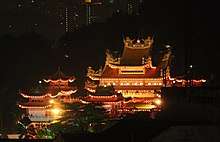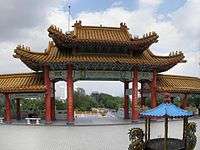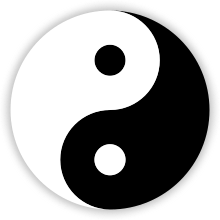Thean Hou Temple
The Thean Hou Temple (Chinese: 乐圣岭天后宫/樂聖嶺天后宮) is a six-tiered temple of the Chinese sea goddess Mazu located in Kuala Lumpur, Malaysia.[2] It is located on 1.67 acres (6,758 m2) of land atop Robson Heights on Lorong Bellamy, overlooking Jalan Syed Putra.[3] It was completed in 1987 and officially opened in 1989.[1][2] The temple was built by Hainanese living in Malaysia and the property belongs to and is run by the Selangor and Federal Territory Hainan Association (Malay: Hainan Selangor and Wilayah Persekutuan; Chinese: 雪隆海南会馆/雪隆海南會館). It is one of the largest temples in Southeast Asia.[4]
| Thean Hou Temple 乐圣岭天后宫/樂聖嶺天后宮 | |
|---|---|
.jpg) Front view of Thean Hou Temple | |
| Religion | |
| Affiliation | Buddhism, Confucianism, Taoism |
| Location | |
| Location | Seputeh, Kuala Lumpur |
| Country | Malaysia |
| Geographic coordinates | 3°7′18″N 101°41′16″E |
| Architecture | |
| Type | Chinese temple |
| Date established | 1981 |
| Completed | 1987[1] |
| Website | |
| www.hainannet.com.my | |
| Thean Hou Temple | |||||||||||||||||
|---|---|---|---|---|---|---|---|---|---|---|---|---|---|---|---|---|---|
 The temple at night. | |||||||||||||||||
| Simplified Chinese | 天后宫 | ||||||||||||||||
| |||||||||||||||||
History
The Thean Hou Temple was constructed from 1981 and completed in 1987 at a cost of approximately RM7 million.[1][2]
The installation dates of the Goddesses are as follows:
- 16 November 1985 — Tian Hou
- 19 October 1986 — Guan Yin
- 16 November 1986 — Shui Wei Sheng Niang
The temple was officially opened on 3 September 1989.[2]
Features
Architectural
This syncretic temple with elements of Buddhism, Confucianism and Taoism is a grandiose structure and represents a successful combination of modern architectural techniques and authentic traditional design featuring imposing pillars, spectacular roofs, ornate carvings and intricate embellishments.[2] Its grand architecture has made it as one of the tourist destination. The front entrance of the temple features a multi-arched gateway with red pillars, the colour symbolic of prosperity and good fortune. Souvenir stalls and a canteen are found on the first level.[3] The second level houses the multi-purpose hall while offices are located on the third level. The fourth level has three tiers and the prayer hall is located here.
- Ceiling art.
 Main gate.
Main gate..jpg) Red pillar with Chinese characters.
Red pillar with Chinese characters..jpg) Roofing art.
Roofing art. The temple overlooking the city of Kuala Lumpur.
The temple overlooking the city of Kuala Lumpur.
Prayer hall

The prayer hall houses three altars, each with a sculpture of one deity or goddess.[3] The altar on the right is dedicated to Guan Yin, the Goddess of Mercy. Tian Hou is in the centre while Shui Wei Sheng Niang (the Goddess of the Waterfront) is at the left.[3] In the middle of the hall and between the altars are two pairs of Kau Cim oracles that can be used by visitors. Despite the dedication to Tian Hou, worship of Guan Yin is a recurrent theme at the temple.[5]
External
In addition to her altar in the prayer hall, there is a smaller statue of Guan Yin to the right of the hall, set amongst rocks and falling water. Here one can kneel and receive a blessing of water from the statue. Outside the temple at the entrance to the grounds, there is a larger statue, similarly set amongst rocks and falling water. Other features include a Chinese Medicinal Herbs Garden, a Wishing Well as well as a Tortoise Pond. There is also a large statue of the goddess opposite the temple, along with a collection of other large statues that include representations of the twelve animals of Chinese astrology.[6]
Activities
Religious and cultural
Activities such as the grand birthday celebrations for Goddess Tian Hou, Goddess Kuan Yin and the Goddess of the Waterfront are conducted at Thean Hou. Buddhist activities include Dharma Prayers and Wesak Day celebrations. Cultural activities include the annual Mid-Autumn Festival during the eighth lunar month and the Chinese New Year celebration.[1][4][7] In 2019, the temple was allocated RM30,000 by the federal government to encourage them to hold more cultural events.[8]
Others
The temple also offers fortune-telling and marriage registration services and traditional Chinese exercise and martial arts activities such as qigong, tai chi and wushu classes are conducted at the temple compound.[9][10]
References
- "Thean Hou Temple kick-starts CNY celebrations with record-breaking artworks". The Sun. 28 January 2017. Retrieved 9 March 2019.
The Thean Hou Temple is a six-tiered temple to the Chinese sea goddess Mazu. Costing RM7 million, the temple was completed in 1987 and officially opened in 1989. About 80,000 visitors, both local and foreign come to the temple during the Chinese New Year period.
- "Thean Hou Temple". VisitKL. Archived from the original on 9 March 2019. Retrieved 9 March 2019.
- "Chap Goh Mei". Tourism Malaysia. 4 February 2016. Archived from the original on 9 March 2019. Retrieved 9 March 2019.
Located on top of Robson Hill off Jalan Syed Putra, its architecture will interest visitors, particularly tourists. Every year, thousands visit the temple to offer prayers to the three deities: the Goddess of the Seas (Thean Hou), the Goddess of the Waterfront (Swei Mei) and the Goddess of Mercy (Kuan Yin). Before leaving the temple, remember to get some souvenirs from the souvenir shops at the lowest level.
- "Mid-Autumn Celebration at Thean Hou Temple". Taiwan Buddhist Tzu Chi Foundation Malaysia. 30 September 2012. Retrieved 9 March 2019.
- Lonely Planet; Simon Richmond; Isabel Albiston (1 June 2017). Lonely Planet Kuala Lumpur, Melaka & Penang. Lonely Planet Global Limited. pp. 223–. ISBN 978-1-78701-060-4.
- "Thean Hou Temple - Kuala Lumpur". Tourism Malaysia. Retrieved 9 March 2019.
- Hasnoor Hussain; Nazir Sufari; David ST Loh (12 February 2018). "Welcoming the year of the dog". The Malaysian Insight. Retrieved 9 March 2019.
- Jerry Choong (31 January 2019). "Loke allocates RM30,000 to Thean Hou Temple, first for 2019". The Malay Mail. Retrieved 9 March 2019.
- "通告" [Announcement]. Malaysia Chenshi Taijiquan Association. Retrieved 9 March 2019.
- "Continuing the legacy of a kungfu master". The Star. 20 December 2005. Retrieved 9 March 2019.
External links

- Official website
.jpg)






